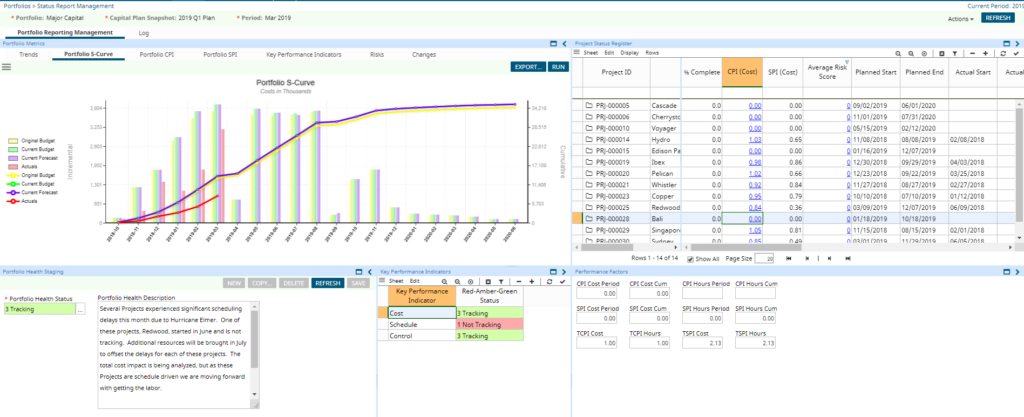
Project KPIs, or Key Performance Indicators, are measurable values that help you evaluate project performance. When executing a project, it is important to develop meaningful KPIs that help ensure projects are delivering intended benefits. This traditionally meant staying within budget and on schedule. But in today’s complex and competitive landscape, KPIs also need to ensure projects are supporting company strategy and goals.
Enterprise Project Performance (EPP) is a mindset that expands from improving outcomes of individual projects to one that also heavily considers achievement of business objectives for ALL projects within your organization.
Why Project KPIs Are Important
With this approach, it’s critical to establish a standard set of Key Performance Indicators (KPIs) across your organization. The purpose behind establishing these metrics is as a method to consistently measure that which has been agreed as important in delivering project (and organizational) successes.
EPP software platforms facilitate this approach by integrating processes that span the full lifecycle of projects, including:
Project Portfolio Management
– helps you prioritize, select, strategically align, and manage projects across all portfolios, from inception to closeout.
Enterprise Project Controls
– improves project outcomes by boosting efficiencies, improving productivity, and increasing predictability in the upcoming new era of capital projects.
Contract Management
– effectively manage your contracts by implementing best practices for communication, tracking, and corrective action.

By integrating these processes and the sub-processes, you can eliminate common errors and data siloes that inhibit visibility into performance. In turn, you have the potential to fully maximize returns and margins across all projects.
SMART Project KPIs
When developing KPIs for your organization, it is important to make sure they are SMART KPIs. This means you need to make sure your project KPIs are Specific, Measurable, Attainable, Realistic, and Timely. SMART is a useful guide for goal setting, and is proven to increase the chances of achieving a goal.

All of these elements should be accounted for in the KPIs embedded within a good EPP solution.
Types of Project KPIs for Performance Measurement
Thriving in the new landscape is possible by using Enterprise Project Performance to leverage key performance indicators that fall into three categories:
Efficiency KPIs
Efficiency KPIs enable teams to reduce the time needed to perform tasks. These can include measurements like:
Time needed to perform tasks
Number of report reviews and revisions
Report cycle timeframes
Response time to workflow actions
Use of common tools and processes
Frequency of tasks delivered on time
Number of resources involved across multiple projects
Predictability KPIs
Predictability KPIs lead to earlier identification of issues and enable corrective action to reduce cost and schedule overruns. These include things like:
Number of late forecast changes
Variation between budget baseline and final actuals
Number of projects completed on time
Consistency of cost performance index (CPI) and schedule performance index (SPI)
Number of budget iterations prior to sanction
Contingency allocated to projects
Number of cancelled projects
Control KPIs
Control KPIs help teams improve the performance of every project in a portfolio and gain consistency in project delivery by enforcing standards. Examples of Control KPIs are:
Amount of project rework
Action/query response times
Consistency in use of terms, classifications, categories, and types
% of risks managed and/or mitigated
Quality and completeness of project deliverables
Financial Impacts of Measuring and Improving Project KPIs
These new measurement tools then unlock the potential for significant improvements to financial and business outcomes:
Reduce project costs by 5% to 10%. This is the result of accurate forecasting, better resource utilization, and controlling risk more effectively.
Reduce opportunity costs by 10% to 30%. EPP makes this possible by enabling project leaders to select the right projects, and helping capital-project organizations effectively allocate resources to those projects.
Reduce related IT and PMO costs by 20% to 40%. Such cost reductions are possible by leveraging EPP to consolidate an organization’s siloed tools. EPP also cuts PMO costs by automating reporting processes and eliminating manual activities that are prone to human error.
Conclusion
If the right KPIs aren’t tracked effectively, it will be difficult for a company to gain actionable insight into the processes that need improvement, as well as effective processes that should be replicated across projects. It’s important to monitor the right mix of key performance indicators so an enterprise can remain competitive while also achieving favorable short-term financial performance. Essential KPIs can shed light on a project’s performance and success. They should be maintained by all parties involved in a capital project. EPP technology can provide a competitive advantage by helping you add and measure these critical KPIs to your projects.